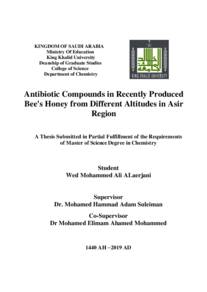Novel Catalysts for Cyclohexane Selective Oxidation
Abstract: The oxidation of cyclohexane to cyclohexanone and cyclohexane (the so called KA oil) is an important reaction in petrochemical industries, because the desired products of this reaction are mainly used as intermediate to produce ε-caprolactam and adipic acid monomers, which are used as raw materials in the manufacturing of Nylon 6 and Nylon 66, respectively. The desired products in this reaction are more susceptible for the oxidation than cyclohexane, this leads to a decrease in the selectivity of KA oil with an increase in the overall conversion. Cyclohexane oxidation in industry is carried out using homogeneous catalysts at low conversion ratio (<6%) to maintain the selectivity in range from 75-85%. Moreover, the homogeneous catalysts are associated with many economic and environmental problems and their replacement by heterogeneous catalysis is crucial, and represents a real challenge for the researchers. This study is aimed to synthesis novel solid and cost-effective catalysts to be used in cyclohexane oxidation. The synthesized catalysts consisting from ions for two different metals incorporated on\in a 3D mesoporous silicate donated as TUD-1. This supporting material characterizes by high surface area, simple and cost-effective preparation technique. The two metals play different roles, the first metal initiates the oxidation process of cyclohexane, while the second accelerates the decomposition of the intermediate, i.e. cyclohexyl hydoperoxide (CHHP), to the KA oil. This simple tactic leads to an obvious increase in the cyclohexane conversion and CHHP decomposition to KA oil during short time, so, decrease the over-oxidation products and then increase their selectivity. The catalysts were prepared by hydrothermal sol/gel technique in one-pot procedure through mixing, drying, hydrothermal treating, and finally calcining the precursors to obtain the final structure of catalysts. The catalysts characterization was carried out by many techniques (1) XRD (2) UV-Vis diffuse reflectance spectroscopy (3) ICP-OES (4) SEM (5) EDX spectroscopy. Catalytic performance study was carried out in a condensation system under high purity N2 gas flow at 343K by using tert-Butyl hydroperoxide (TBHP) as an oxidant and free-solvent for 8h. Then, the reaction solutions were analyzed by gas chromatography.g XRD patterns showed a similar structure for TUD-1, moreover, in a limited number of materials, the presence of bulk crystals of metals or metal oxides with a size higher than 5 nm were clearly visible. UV-Vis diffuse reflectance spectra showed that the metals were incorporated by different forms and ions according to their types and concentrations, either in or on silica framework. SEM showed the morphological structure of TUD-1 samples as a non-uniform particle-like structure. EDX showed the purity of the samples in addition to the elements' samples. Moreover, ICP elemental analysis accurately quantified the exact amount of each element present in the prepared materials. The catalytic performance of the prepared materials showed that the prepared catalysts, which contain two different metals, are more active than that of solo metals. In additional, CHHP was detected at very low levels. The highest conversion was obtained by Co-Cr-TUD-1, where, it reached to 42.6% with high selectivity to MOP 88.8%. Leaching of metal focused the most of the synthesized catalysts. Accordantly, MnCo-TUD-1 was selected as the best catalysts based on many factors (1) achieved high stability, (2) cyclohexane conversion reached to 12.3%, and (3) excellent MOP selectivity reached to 90.4%. Moreover, it reused 3 times without losing its activity.
